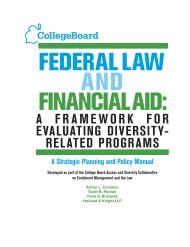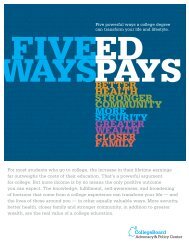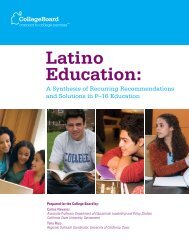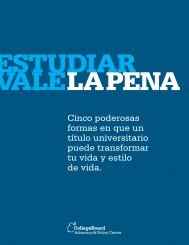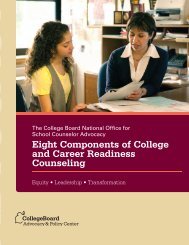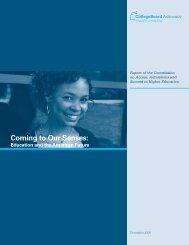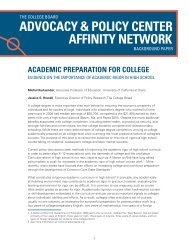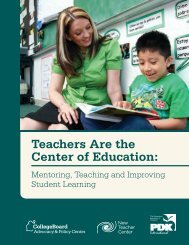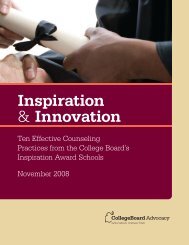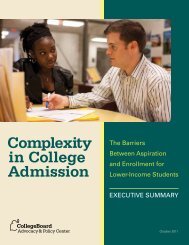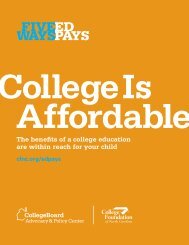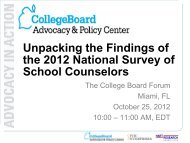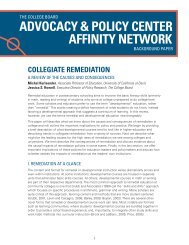Transforming the Educational Experience of Young Men of Color
Transforming the Educational Experience of Young Men of Color
Transforming the Educational Experience of Young Men of Color
You also want an ePaper? Increase the reach of your titles
YUMPU automatically turns print PDFs into web optimized ePapers that Google loves.
Greater Than <strong>the</strong> Sum <strong>of</strong> Its Parts by Jennifer A. Dunn<br />
Recommendations<br />
Relevant to <strong>the</strong> School<br />
Counselor and <strong>the</strong><br />
Counseling Practice:<br />
Increase community, business<br />
and school partnerships.<br />
Reform education to ensure<br />
college and career readiness.<br />
Enhance cultural- and genderresponsive<br />
training.<br />
Improving <strong>the</strong> existing educational outcomes for our young men <strong>of</strong> color will<br />
take new ideas and a concerted effort. Our communities must stand toge<strong>the</strong>r<br />
by swiftly adopting <strong>the</strong> mantra “<strong>the</strong> whole is greater than <strong>the</strong> sum <strong>of</strong> its parts.”<br />
Collectively, with schools, not-for-pr<strong>of</strong>it, faith-based and business organizations,<br />
we can break <strong>the</strong> status quo and improve <strong>the</strong> educational outcomes <strong>of</strong> our young<br />
men <strong>of</strong> color; if attempted separately and piecemeal, <strong>the</strong> status quo will remain.<br />
In <strong>the</strong> first volume <strong>of</strong> <strong>the</strong> School Counselor Journal series, we explored <strong>the</strong><br />
importance <strong>of</strong> enabling our young men <strong>of</strong> color to maintain a healthy identity, free<br />
from <strong>the</strong> negative pressures <strong>of</strong> cultural assimilation. In this volume <strong>of</strong> <strong>the</strong> Journal<br />
series, a diverse group <strong>of</strong> organizations and individuals share <strong>the</strong>ir experiences<br />
with building strong, vibrant and successful community partnerships that position<br />
our young men <strong>of</strong> color for future success in college and career readiness.<br />
As our young men <strong>of</strong> color journey through <strong>the</strong> K–12 pipeline toward college<br />
completion, <strong>the</strong>y will rely on partnerships as an integral part <strong>of</strong> <strong>the</strong>ir system <strong>of</strong><br />
supports. These partnerships can provide a venue for educators to problem-solve,<br />
expand resources and develop new practices that can build beyond <strong>the</strong> traditional<br />
capacity <strong>of</strong> schools. In <strong>the</strong> writings that follow, you will see several emerging<br />
<strong>the</strong>mes that can inform your role as a school counselor for young men <strong>of</strong> color.<br />
The Community: Communities must become places <strong>of</strong> promise for<br />
supporting <strong>the</strong> social growth and development <strong>of</strong> our young men <strong>of</strong> color.<br />
Educators should take every opportunity to bridge community traditions, activities<br />
and cultural events to empower young men and help <strong>the</strong>m counteract negative<br />
stereotyping and labels that can exclude and/or minimize who <strong>the</strong>y are.<br />
Alternative Pathways: <strong>Young</strong> men <strong>of</strong> color need a variety <strong>of</strong> pathways<br />
to learn and engage in <strong>the</strong>ir school environment. Community and school-based<br />
programs, clubs and organizations can provide experiential learning opportunities<br />
for young men to build a dignified and constructive identity. This newfound<br />
confidence empowers <strong>the</strong>m to take action and build <strong>the</strong>ir own successful future.<br />
<strong>Men</strong>torship: The needs <strong>of</strong> young men <strong>of</strong> color are varied. As a result, schools<br />
are <strong>of</strong>ten unable to personalize <strong>the</strong> learning environment to ensure that young men<br />
<strong>of</strong> color receive <strong>the</strong> right supports to progress successfully through <strong>the</strong> education<br />
system. The presence <strong>of</strong> guides, mentors and supportive relationships inside and/<br />
or outside <strong>of</strong> <strong>the</strong> school can better position our young men <strong>of</strong> color for positive<br />
educational outcomes.<br />
We hope what you have read here will challenge you to go outside <strong>of</strong> your<br />
comfort zone. Find inspiration and insight in <strong>the</strong> powerful and moving experiences<br />
<strong>of</strong> <strong>the</strong> featured voices <strong>of</strong> <strong>the</strong> authors and artists. As school counselors, we have a<br />
unique opportunity to step up and lead <strong>the</strong> charge to mobilize our communities<br />
to take action. When we work toge<strong>the</strong>r, we can build powerful partnerships that<br />
invest in our communities and <strong>the</strong> educational success <strong>of</strong> our young men <strong>of</strong> color.<br />
I would like to thank <strong>the</strong> authors and artists represented in this publication<br />
for sharing <strong>the</strong>ir expertise and personal perspectives on increasing community,<br />
business and school partnerships. n<br />
Jennifer A. Dunn is <strong>the</strong> director <strong>of</strong> <strong>the</strong> National Office for School Counselor Advocacy.<br />
<strong>Transforming</strong> <strong>the</strong> <strong>Educational</strong> <strong>Experience</strong> <strong>of</strong> <strong>Young</strong> <strong>Men</strong> <strong>of</strong> <strong>Color</strong>: Increase Partnerships | 1




